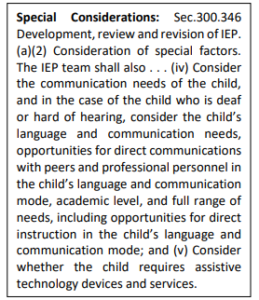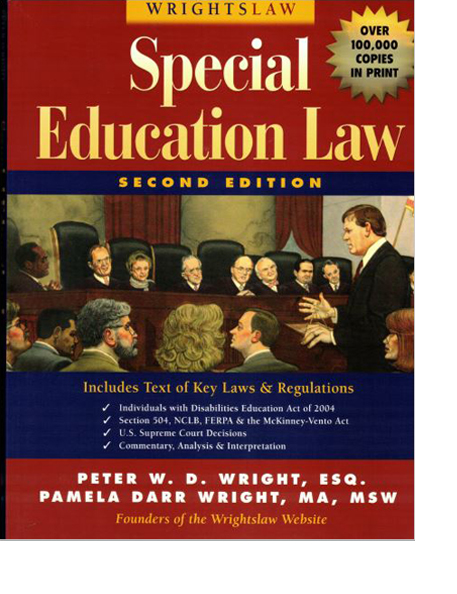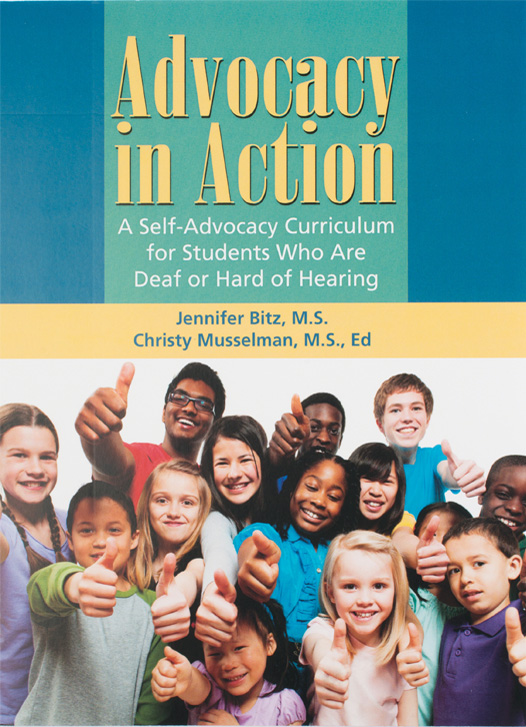Related Products
For Professionals
- Amplification
- Assessment of Student Skills, Challenges, Needs
- Early Childhood: Infants, Toddlers, Preschool
- Hearing Loss – Identification, Impact and Next Steps
- IDEA Law Summary Information
- Language and Speech Development Issues
- Legal Issues in Serving Children with Hearing Loss
- Listening (Auditory Skills) Development
- Planning to Meet Student Needs
- Self-Advocacy Skills for Students with Hearing Loss
- Self-Concept: How the Child with Hearing Loss Sees Himself
- Social Skills
- Speech Perception & Learning
Related Teacher Tools Takeout Items
“Special Considerations” and LRE for Students who are DHH
 While the educational prognosis for students with hearing loss has never been as promising as it is now, we continue to have students who are deaf or hard of hearing who have not been identified, or who have not received intervention, prior to school entry. We have all encountered students with two or more years of language delay at kindergarten age. The “Special Considerations” clause and other portions of the IDEA law provide requirements for how school teams should plan the least restrictive environment (LRE) to support effective educational programs for all students who are deaf or hard of hearing.
While the educational prognosis for students with hearing loss has never been as promising as it is now, we continue to have students who are deaf or hard of hearing who have not been identified, or who have not received intervention, prior to school entry. We have all encountered students with two or more years of language delay at kindergarten age. The “Special Considerations” clause and other portions of the IDEA law provide requirements for how school teams should plan the least restrictive environment (LRE) to support effective educational programs for all students who are deaf or hard of hearing.
Lost intervention opportunities: Over 25% of infants who failed newborn hearing screening had no documented diagnosis of hearing ability. Although many students with hearing loss receive early identification followed by early intervention, almost 20% of those who were diagnosed with a hearing loss following newborn hearing screening did not receive early intervention.
Some children receive cochlear implants as infants or toddlers without the necessary intensive intervention to develop age-appropriate oral language. Other families choose to use sign language without the needed instruction in ASL or connections with the Deaf community to develop fluency, even to meet the vocabulary growth needs of a young child. Still other families ‘want it all’ but are not provided intensive support by skilled interventionists to be able to provide both a rich auditory and visual communication environment.
Such missed opportunities for early development can result in a scenario like the following:
“We have a student entering kindergarten who received cochlear implants at ages 2 and 3. His oral language development is 2 years delayed. Because he is so delayed, the school team is suggesting we put an interpreter with him in a regular kindergarten class. The family knows a few signs but they want him to listen and speak. How do we figure out the most appropriate program for him?”
Note:
The recent Optimizing Outcomes for Students who are Deaf or Hard of Hearing Educational Service Guidelines (NASDSE, September 20181) and the still relevant policy guidance on Deaf Students Education Services (US Department of Education, 19922) are both valuable resources in helping to answer this question.
Full-Inclusion as a Driver: With the push toward full inclusion in the classroom, including limiting pull-out for specialized instruction, school teams may seek to provide an interpreter in the situation above as a way to address communication needs in the inclusive environment. However, for the varying communication needs of students with hearing loss, an interpreter may be an inappropriate solution, or only a part of a solution, to meet these communication needs. As made clear from the following paragraph2, school teams must thoroughly understand a student’s communication needs, how to provide the least restrictive educational environment and the appropriately intensive specialized instruction in light of those communication needs.
Meeting the unique communication and related needs of a student who is deaf is a fundamental part of providing a free appropriate public education (FAPE) to the child. Any setting which does not meet the communication and related needs of a child who is deaf, and therefore does not allow for the provision of FAPE, cannot be considered the LRE for that child. A full range of alternative placements as described at 34 CFR 300.551(a) and (b)(1) of the IDEA regulations must be available to the extent necessary to implement each child’s IEP. There are cases when the nature of the disability and the individual child’s needs dictate a specialized setting that provides structured curriculum or special methods of teaching. Just as placement in the regular educational setting is required when it is appropriate for the unique needs of a child who is deaf, so is removal from the regular educational setting required when the child’s needs cannot be met in that setting with the use of supplementary aids and services.” 2
To consider these language and communication special factors, the IEP team should ask1:
- What is the child’s primary language and mode of communication?

- What communicative needs and opportunities does the child have? Can he comprehend what is said in school?
- Does the child have the skills and strategies necessary to meet those communicative needs and take advantage of communication opportunities? (social, self-advocacy)
- Can the child fulfill his or her need to communicate in different settings? (listening in noise, social situations)
- Does the child communicate appropriately and effectively, and if not, why not? (full participant in class?)
Strategies to Obtain Information About Communication Needs
Considerations for the school team to answer what communication services are appropriate include:
-
- 1. What is his most effective communication mode of communication? The PARC checklists should help to tease this out (PARC Instructional Communication Access Checklist, followed by the appropriate grade level readiness checklist).
-
- 2. What is his degree of delay compared to the language level of typical peers? An extensive language assessment must be performed, including listening comprehension. If providing an interpreter is being discussed, then assessment needs to be performed to determine his development level with both languages. Assessments that provide age expectations for learning ASL can be found in this document.
-
- 3. Is there reason to believe that there is a cognitive component that is further impairing language growth (nonverbal IQ measure by someone skilled in DHH cognitive assessment)? When provided appropriately intensive services focused on oral language development was rapid progress made? Given intensive ASL instruction, not just interpreter services, does he pick up language at a rapid rate?
-
- 4. What intensity of services are required for him to learn language at a pace of more than one month of development for one month of time? The school team can complete this matrix that assists teams in teasing out student communication, skill level, impact of hearing loss on education and resulting service intensity needs. This is a situation where it is highly likely that a full-day inclusive classroom setting is the most restrictive placement for a student to receive FAPE.
-
- 5. What service providers are need for him to develop language quickly? A teacher of the deaf/hard of hearing and/or speech clinician with extensive training in oral education of students with hearing loss is likely necessary to reach the eventual goal of age-appropriate language.
Targeted assessment data is necessary to determine appropriate placement and IEPs goals. Appropriately educating most students with hearing loss requires specialized knowledge, appropriate intensity of DHH services, accessibility accommodations for effective classroom communication, and contact with DHH peers.



